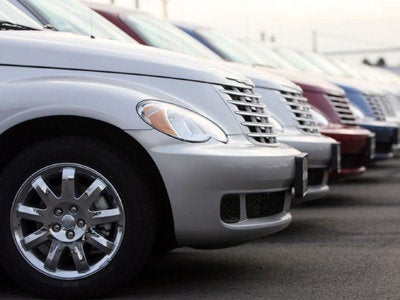
If you've been following mainstream news stories or conservative Republicans, you've probably heard claims about those inefficient UAW members supposedly making $70 an hour, including benefits, making unions the prime culprit in the failures of the Big 3 automakers.
But it's all a big lie, swallowed whole by union-bashing pundits even in The New York Times. One example of the lie: the $70 figure comes in part from measuring all health benefits and pensions paid to 450,000 UAW retirees and their families. In truth, as economist Mark Brenner, the co-director of Labor Notes, points out in an insightful op-ed and in an interview with me:
The only place where pundits, politicians and Big Three executives seem to agree is that autoworkers will have to make do with less or kiss their jobs goodbye. But imposing more pain on rank-and-file autoworkers can't solve Detroit's problems. Automakers have already wrung billions in concessions out of the United Autoworkers over the last three years, and even if union workers agreed to work for free it would only shave 5 percent off the cost of their cars.
Let's repeat that point: if the autoworkers worked for no salary at all, it would cut just 5 percent off the cost of their cars. That's a stastical nugget Brenner found by burrowing into the latest economic census data and matching it with manufacters' costs. Before the UAW made billions of dollars in concessions that lowered UAW's labor costs in 2007, the union cited similar data in answering this question:
How much are labor costs in relation to the total price of a new vehicle?
The total labor cost of a new vehicle produced in the United States is about $2,400, which includes direct, indirect and salaried labor for engines, stamping and assembly at the automakers' plants.
This represents 8.4 percent of the typical $28,451 price of a new vehicle in 2006. The vast majority of the costs of producing a vehicle and transporting it to a dealership and preparing it for sale - including design, engineering, marketing, raw materials, executive compensation and other costs - are not related to direct or indirect manufacturing labor.
Now, for UAW workers at the Big Three companies, the percentage of total car costs accounted for by wages is down to as little as five percent.
Armed with facts like those, last week, Jonathan Cohn of the New Republic and Brenner offered a clear-eyed assessment of what's gone wrong in the auto industry and what needs to be done on the radio show I co-host, the "D'Antoni and Levine Show," in part by challenging the myths and lies aimed at the UAW.
The smears and distortions continued this past Sunday. On Meet the Press, Chuck Todd falsely claimed (at the 4:40 minute mark) that the UAW should have been on Capitol Hill this past week, too. In fact, UAW's president Ron Gettlefinger testified at both panels with the auto executives. That's a small example of the distortions and outright lies that have spread about the union this past week, paving the way for undermining worker's rights by blocking the proposed Employee Free Choice Act that promotes a fair playing field for union organizing. (One key myth: workers aren't allowed to cast a secret ballot under the "card-check" proposal. But they are free to choose to having a secret-ballot election, rather than a majority vote card-check, if they want. But the current system is rigged against workers.)
Of course, most of the Big Three leadership, especially at GM, deserves to be fired. Paul Ingrasia of The Wall Street Journal, a Pulitzer Prize-winner for covering the auto industry, is skeptical about a bailout, but he points out:
Let's assume that the powers in Washington -- the Bush team now, the Obama team soon -- deem GM too big to let fail. If so, it's also too big to be entrusted to the same people who have led it to its current, perilous state, and who are too tied to the past to create a different future.
In return for any direct government aid, the board and the management should go. Shareholders should lose their paltry remaining equity. And a government-appointed receiver -- someone hard-nosed and nonpolitical -- should have broad power to revamp GM with a viable business plan and return it to a private operation as soon as possible.
If we let the industry fail, as many as three million workers with direct and indirect ties to the auto industry could lose their jobs.
But before the auto industry gets a bail-out, we have to clearly look at the realities underlying the current crisis, and, today, after billions of dollars in concessions, it's simply wrong to blame the UAW for the auto industry's ills. In the smartest new article on the auto industry, the savvy Jonathan Cohn points out:
But what's missing in the tsk-tsk editorials is any recognition that the culture of Detroit has been changing, however belatedly, starting with its labor relations. Ford led the way years ago by reaching site-specific "competitive operating agreements" with locals at different plants, rather than sticking to one national agreement, thereby enabling it loosen work rules and engage in the sort of collaborative quality management on which industry leader Toyota made its reputation. Then, last year, the UAW reached a breakthrough agreement in which it granted the companies similar flexibility, agreed to a two-tier wage structure for new hires, and set up a separate trust fund to finance future retiree health benefits. The companies would provide the initial money for this trust, but, henceforth, the unions would manage it--thereby taking off the companies' books a tremendous burden that had, on its own, accounted for about half the gap in compensation between unionized workers for the Big Three and non-unionized workers for foreign-owned automakers. "I think they've shown unprecedented ability to change and transform the union," says Kristin Dziczek, who directs CAR's Automotive Labor and Education program. "They understand what is at stake."
So far, the results are promising. According to the most recent Harbour Report, the benchmark guide for manufacturing prowess, Chrysler's factories now match Toyota's for the most productive, while both Ford's and GM's are improving. (A Toledo Jeep factory was actually named the nation's most efficient.) Consumer Reports now says Ford's reliability is approaching that of perennial leaders Honda and Toyota, whose ratings actually slipped last year. In late 2010, GM will introduce the Chevrolet Volt, a plug-in hybrid that can go 40 miles without gas, and the Chevrolet Cruze, a compact that relies solely on gas but that gets 45 miles to the gallon. The Volt would represent a rare leap ahead of the Japanese, who never embraced plug-in technology with the same enthusiasm. It's also typical of the better cars that observers say Detroit has in store. "There's a lot of accumulated negativity about these companies out there," says Wharton's John Paul MacDuffie, who directs the International Motor Vehicle Program. "U.S. consumers gave the Big Three the benefit of the doubt for a long time before turning away from them, and now their reputation is worse than their actual performance and progress toward needed reforms."
Brenner of Labor Notes believes the union has already given away too much in concessions, noting that all newly hired union auto workers can only be paid $14 an hour. "Can you have a middle-class life, pay for college and buy a house with a $14 an hour wage?" Brenner argues. "I don't think so."
In fact, it seems that American automakers are on their way to matching or beating labor costs of Japanese auto plants in Southern non-union states, such as Alabama.
Actually, as both Brenner and Cohn argue, this current crisis raises the stakes for moving forward on pursuing alternative enegry and ending the dependence on oil -- as well as providing national health insurance.
Cohn puts it all in a broader context:
But, if the government demands that the Big Three and its workers live up to more obligations, the government--which is to say, the taxpaying public--must live up to some obligations of its own. Companies like Honda operate out of countries that made health and retirement benefits a national responsibility. And the perennially high price of gasoline, a product of high gas taxes in virtually all other highly developed countries, has ensured a steady market for their smaller, more fuel-efficient vehicles. There's no reason not to treat U.S. car companies, and car owners, the same way.
For now, that would mean government would assume some health and pension obligations (which it would have to do in a bankruptcy anyway, though its Pension Benefit Guaranty Corporation) while subsidizing the purchase of fuel-efficient cars (something it is already planning to do, thanks to recent tax changes). But the debate over a Detroit bailout should begin a larger political conversation, one that sprawls beyond the Midwest and the intellectual confines of lean production techniques and workers' legacy costs. Whatever mistakes the Big Three and the UAW have made, their struggles are a pretty good indicator of why the government--not employers--should be responsible for providing health insurance and why, without broader action to fight climate change, improving fuel efficiency will be a struggle. Naturally, the Big Three should enthusiastically promote these reforms, something they haven't done in the past.
A good place to start on all this to stop blaming today's United Auto Workers for being a primary cause of the auto industry's crisis.
UPDATE:Media Matters columnist Eric Boehlert weighs in today with an excellent column citing countless examples of how this $70-an-hour myth is beling peddled -- and its implications. He writes:
But having the media echo conservative misinformation and bandy about urban-myth salary figures about allegedly high-on-the-hog GM workers does not constitute a careful review of the facts.
Question: Is the press just being sloppy on this issue of supposedly pampered autoworkers, or are there other elements in play? Because honestly, I've had trouble escaping the not-very-subtle elitist, get-a-load-of-this tone that has run through the media's misinformation on the topic; i.e., "These autoworkers get paid that?!"
Answer: No, they don't, so please stop reporting it. (And why has the press been so reticent to note that Big Three autoworkers recently made significant concessions to management?)
And it's funny, because I don't remember hearing much coverage in the press about AIG workers' six- and seven-figure salaries when the U.S. government announced it was bailing out the insurance giant. And I haven't seen or heard a single press reference to the annual salaries pocketed by Citigroup employees, even though the government has moved in quickly to bail the banking giant out of a hole its executives dug.
As Rep. Barney Frank (D-MA) pointed out during congressional hearings last week, "There is apparently a cultural condition that's more ready to accept aid to a white-collar industry than the blue-collar industry, and that has to be confronted."
That cultural condition seems to extend to, and be embraced by, today's white-collar press corps.
Make no mistake: The $70-an-hour claim represents a classic case of conservative misinformation. It's also a very dangerous one. The falsehood about autoworkers is being spread at a crucial time, when a make-or-break public debate is taking place, a debate that could affect millions of American workers.
